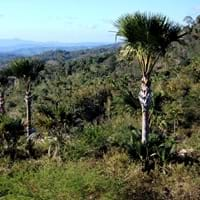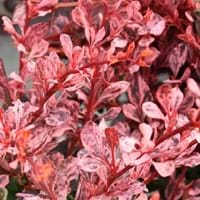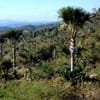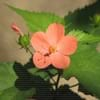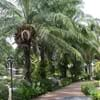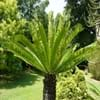Life Span
Perennial
Perennial
Origin
Southern Asia, Southeastern Asia, India, Melanesia, Australia
Eastern Asia, Japan
Types
Gebang Palm
Not Available
Number of Varieties
Not Available
Habitat
tropical environments
Old fields, stream banks
USDA Hardiness Zone
10-15
4-8
Sunset Zone
H1, H2
A3, 2b, 3a, 3b, 4, 5, 6, 7, 8, 9, 10, 11, 12, 13, 14, 15, 16, 17, 18, 19, 20, 21, 22, 23, 24
Habit
Upright/Erect
Oval or Rounded
Flower Color
Ivory
Yellow, Yellow green
Flower Color Modifier
Bicolor
Not Available
Fruit Color
Olive, Chocolate, Black
Red orange
Leaf Color in Spring
Green
Light Green
Leaf Color in Summer
Green, Dark Green
Green
Leaf Color in Fall
Green, Dark Green
Purple, Orange, Burgundy, Crimson
Leaf Color in Winter
Green, Dark Green
Not Available
Leaf Shape
feather-shaped
Obovate
Plant Season
Spring, Summer, Fall, Winter
Spring, Summer, Fall, Winter
Sunlight
Full Sun, Partial Sun
Full Sun, Partial Sun
Growth Rate
Medium
Medium
Type of Soil
Loam, Sand
Clay, Loam, Sand
The pH of Soil
Acidic, Neutral
Acidic, Neutral, Alkaline
Soil Drainage
Well drained
Average
Bloom Time
Indeterminate
Spring, Late Spring
Tolerances
Drought
Pollution, Drought, Salt, Soil Compaction
Where to Plant?
Ground, Pot
Ground, Pot
How to Plant?
Rooted stem cutting, Seedlings
Seedlings
Plant Maintenance
Medium
Medium
Watering Requirements
Average Water Needs, Needs 2-3 times watering per week, Water daily during growing season
Requires regular watering during dry weather
In Summer
Lots of watering
Lots of watering
In Spring
Moderate
Moderate
In Winter
Average Water
Average Water
Soil pH
Acidic, Neutral
Acidic, Neutral, Alkaline
Soil Type
Loam, Sand
Clay, Loam, Sand
Soil Drainage Capacity
Well drained
Average
Sun Exposure
Full Sun, Partial Sun
Full Sun, Partial Sun
Pruning
Remove damaged leaves, Remove dead branches, Remove dead leaves
Remove damaged leaves, Remove dead branches, Remove dead leaves
Fertilizers
All-Purpose Liquid Fertilizer
All-Purpose Liquid Fertilizer
Pests and Diseases
Red blotch
Red blotch, Sunken patches
Plant Tolerance
Drought
Drought
Flowers
Showy
Insignificant
Flower Petal Number
Not Available
Single
Foliage Texture
Bold
Medium
Foliage Sheen
Glossy
Matte
Attracts
Not Available
Birds
Allergy
Asthma, Rhinitis
Not Available
Aesthetic Uses
Decorating walls, Landscape Designing, Showy Purposes
Borders
Beauty Benefits
Not Available
Not Available
Environmental Uses
Air purification
Air purification
Medicinal Uses
Aging, Brain disease, Cancer, Cyanide Poisoning, High blood pressure, High cholestrol, Malaria, Metabolic disorders, Vitamin A, Weight loss
Anthelmintic, Antibacterial, Antiseptic, Cancer
Part of Plant Used
Fruits, Leaves, Tree trunks
Fruits, Leaves
Other Uses
Biodiesel, For making oil, Jelly, Sometimes used for making wine, Used in salads, Wax
Used to make yellow dye
Used As Indoor Plant
No
No
Used As Outdoor Plant
Yes
Yes
Garden Design
Feature Plant, Tropical
Edging, Foundation, Hedges, Mixed Border, Rock Garden, Wall
Botanical Name
CORYPHA utan
BERBERIS thunbergii
Common Name
Buri Palm, Gebang Palm
Japanese Barberry
In Hindi
Buri Palm
Japanese Barberry
In German
Schopfpalmen
Thunberg-Berberitze
In French
Buri Palm
Berberis thunbergii
In Spanish
Buri Palm
Berberis thunbergii
In Greek
Buri Palm
Japanese Barberry
In Portuguese
Buri Palm
Japanese Barberry
In Polish
Buri Palm
Berberys Thunberga
In Latin
Buri Palm
Japanese Barberry
Phylum
Vascular plant
Magnoliophyta
Class
Monocots
Magnoliopsida
Order
Arecales
Ranunculales
Family
Arecaceae
Berberidaceae
Clade
Angiosperms, Commelinids, Monocots
Angiosperms, Eudicots
Tribe
Corypheae
Not Available
Subfamily
Coryphoideae
Not Available
Number of Species
Not Available
Not Available
Importance of Buri Palm and Rose Glow Barberry
Want to have the most appropriate plant for your garden? You might want to know the importance of Buri Palm and Rose Glow Barberry. Basically, these two plants vary in many aspects. Compare Buri Palm and Rose Glow Barberry as they differ in many characteristics such as their life, care, benefits, facts, etc. Every gardener must at least have the slightest clue about the plants he wants to plant in his garden. Compare their benefits, which differ in many ways like facts and uses. The medicinal use of Buri Palm is Aging, Brain disease, Cancer, Cyanide Poisoning, High blood pressure, High cholestrol, Malaria, Metabolic disorders, Vitamin A and Weight loss whereas of Rose Glow Barberry is Anthelmintic, Antibacterial, Antiseptic and Cancer. Buri Palm has beauty benefits as follows: Not Available while Rose Glow Barberry has beauty benefits as follows: Not Available.
Compare Facts of Buri Palm vs Rose Glow Barberry
How to choose the best garden plant for your garden depending upon its facts? Here garden plant comparison will help you to solve this query. Compare the facts of Buri Palm vs Rose Glow Barberry and know which one to choose. As garden plants have benefits and other uses, allergy is also a major drawback of plants for some people. Allergic reactions of Buri Palm are Asthma and Rhinitis whereas of Rose Glow Barberry have Not Available respectively. Having a fruit bearing plant in your garden can be a plus point of your garden. Buri Palm has showy fruits and Rose Glow Barberry has showy fruits. Also Buri Palm is not flowering and Rose Glow Barberry is not flowering . You can compare Buri Palm and Rose Glow Barberry facts and facts of other plants too.
